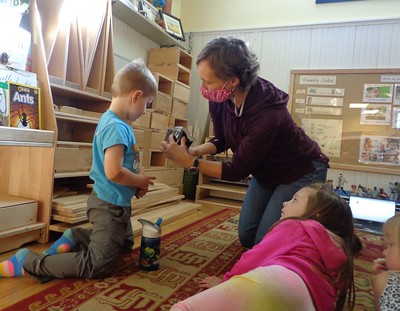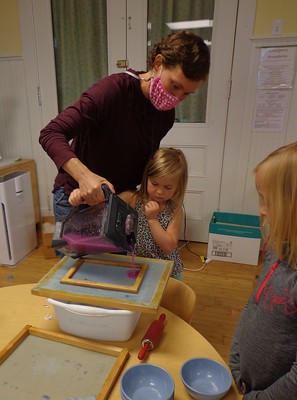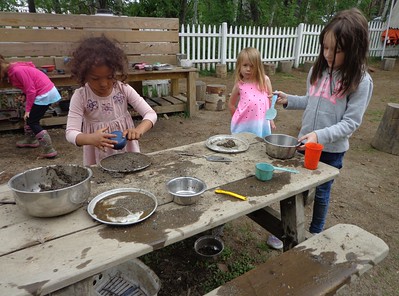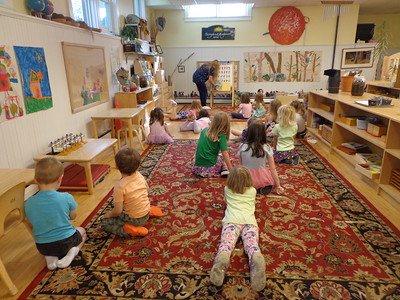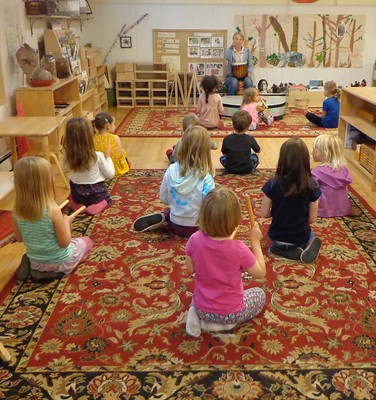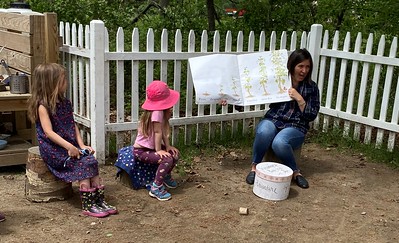As we are planting and growing beans and flowers, and discussing the life cycle of plants and trees, we explored how paper is made. We talked about all the things we use that are made from plants and trees, and found so many things in our classroom made of wood and plant fibers. We looked at the bean plants Friday students planted and observed that they were starting to send down roots. We read about how paper is made and watched a video showing the process and the giant paper factories where trees are debarked, chopped up, combined with water and chemicals and turned into pulp, rolled out into sheets, cut to size, and packaged to be shipped off. The children then recycled some used paper by tearing it into small pieces, blending it up with some water, then pouring out the pulp, rolling out the water, and setting it on heavy fabric to dry.
All the Woodland Stone Soup Practice came to fruition this week as the children performed their story in front of the camera. They donned their costumes and were recorded in scenes, starting with the final scene, then going back to the beginning. Laura is going to work some magic to cut, paste, add sound, and use all those editing skills she has to piece it all together for everyone to view.
The heat at the beginning of the week gave way to cooler end of week temperatures, which was a relief after reaching almost 90 degrees!
Rose read and signed another Llama, Llama story this week. She shared Llama, Llama and the Bully Goat about a student at school who would push, tease, and hurt the other students. Llama and his friends told the bully goat to stop and told the teacher, who came to help and removed the bully goat from play. To wrap up, we signed and sang “Down by the Bay” and the children made up some very creative silly rhymes.
Susan introduced drumming and rhythm patterns. We learned that in some places, because drums are so loud, they are/were a form of communication that would send messages from far away, and different rhythm patterns meant different things, such as a warning that a lion was nearby. She demonstrated how to make a rhythm pattern that we would then imitate. She drummed a pattern and we used rhythm sticks to repeat it back. She showed us how to use the heels of our hands to make a resonating sound on the big drum and the children took turns in small groups playing the big drum using the heels of their hands.
During Spanish we sang the emotions song and all our body songs and marched around the playground while singing and acting out La Marcha. She read the story El Frijole de Benito about a cat who plants a bean and takes care of it then waits and waits and waits for it to grow. To wrap up, we played a color finding game. Zeanny would say a color in Spanish then everyone would run to touch something of that color.
Michelle introduced the life cycle of a bean and the parts of a plant during Friday science. The children observed how the bean seeds they planted last week have started to push down roots and push up sprouts. Some have even emerged from the soil and grown leaves so they can begin to make their own food. She shared some seedlings that have grown leaves, started to bud, and developed into tiny little bean pods. The children found the stem, roots, buds, flowers, pods, branches, and leaves. They each took a bean pod and opened it up to discover the tiny bean seeds inside. It was so neat to see all the different stages and think about the life cycle of the bean plant.

